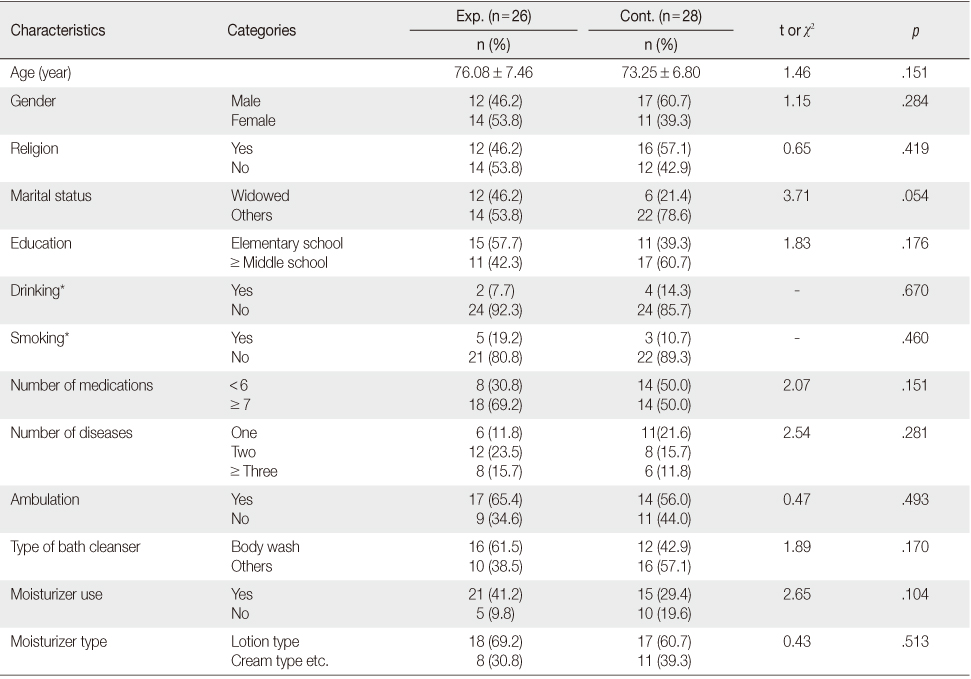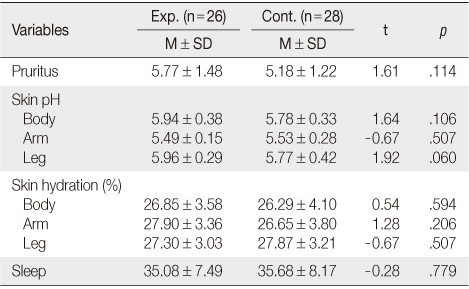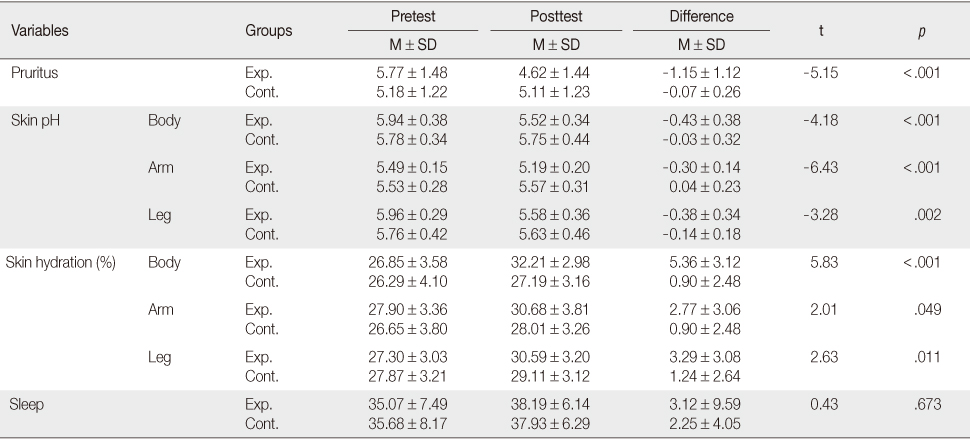Articles
- Page Path
- HOME > J Korean Acad Nurs > Volume 43(6); 2013 > Article
-
Original Article
- Effects of Aroma Massage on Pruritus, Skin pH, Skin Hydration and Sleep in Elders in Long-term Care Hospitals
- So Young Roh, Kye Ha Kim
-
Journal of Korean Academy of Nursing 2013;43(6):726-735.
DOI: https://doi.org/10.4040/jkan.2013.43.6.726
Published online: December 31, 2013
1Department of Nursing, Chodang University, Muan, Korea.
2Department of Nursing, Chosun University, Gwangju, Korea.
- Address reprint requests to: Kim, Kye Ha. Department of Nursing, Chosun University, 375 Seosuk-dong, Dong-gu, Gwangju 501-759, Korea. Tel: +82-62-230-6326, Fax: +82-62-230-6329, kyehakim@hanmail.net
© 2013 Korean Society of Nursing Science
Abstract
-
Purpose
- The purpose of this study was to examine the effects of aroma massage on pruritus, skin pH, skin hydration and sleep in elders in long-term care hospitals.
-
Methods
- The participants were elders over 65 years old admitted to long-term care. They were assigned to the experimental group (26) or control group (28). Data were collected from May to August, 2012. Visual Analogue Scale and Verran and Snyder-Halpern Sleep scale were used to identify levels of pruritus and sleep. A skin-pH meter and moisture checker were used to measure skin pH and skin hydration. Aroma massage was performed three times a week for 4 weeks for elders in the experimental group. The data were analyzed using the SPSS Win 17.0 program.
-
Results
- There were significant differences in pruritus, skin pH and skin hydration between the two groups. However there was no significant difference in sleep.
-
Conclusion
- The results indicate that aroma massage is effective in reducing pruritus, skin pH and increasing skin hydration in elders. Therefore, this intervention can be utilized in clinical practice as an effective nursing intervention to reduce pruritus in elders in long-term care hospitals.
This is manuscript is based on a part of the first author's doctoral dissertation from Chosun University.
- 1. Buckle J. Literature review: Should nursing take aromatherapy more seriously? Br J Nurs. 2007;16(2):116–120.ArticlePubMed
- 2. Chang SB, Chu SH, Kim YI, Yun SH. The effects of aroma inhalation on sleep and fatigue in night shift nurses. J Korean Acad Adult Nurs. 2008;20(6):941–949.
- 3. Chang SY. Effects of aroma hand massage on pain, state anxiety and depression in hospice patients with terminal cancer. J Korean Acad Nurs. 2008;38(4):493–502. http://dx.doi.org/10.4040/jkan.2008.38.4.493Article
- 4. Cheong KJ, Yun MY, Chin CH, Song HH, Lee S, Cheong KJ. A study on the effects of aroma blending oil (carrot seed, geranium, lemon, jojoba) on atopy dermatitis. Korean J Aesthet Cosmet Soc. 2010;8(3):11–20.
- 5. Cheong YG. The effects of specific essential oils on the ages skin with xerosis. Seoul, Chungang University. 2007;Unpublished master's thesis.
- 6. Choi EH, Park HY. Skin barrier in aged skin. J Skin Barrier Res. 2010;12(1):79–84.
- 7. Cowdell F. Care and management of patients with pruritus. Nurs Older People. 2009;21(7):35–41. http://dx.doi.org/10.7748/nop2009.09.21.7.35.c7277ArticlePubMed
- 8. Elsner P, Maibach HI. The effect of prolonged drying on transepidermal water loss, capacitance and pH of human vulvar and forearm skin. Acta Derm Venereol. 1990;70(2):105–109.ArticlePubMedPDF
- 9. Han AK, Won JS, Kim OS. Skin hydration status and skin surface pH according to the body parts of the aged with immobilization. J Korean Acad Fundam Nurs. 2010;17(3):314–323.
- 10. Jeon MY, Kim HS. A study on hygiene and skin pruritus in rural elderly people. J Korean Acad Fundam Nurs. 2008;15(3):342–349.
- 11. Kang U. The effects of specific essential oils on skin pH and skin hydration in atopic dermatitis. Seoul, Chungang University. 2006;Unpublished master's thesis.
- 12. Kelsay K, Klinnert M, Bender B. Addressing psychosocial aspects of atopic dermatitis. Immunol Allergy Clin North Am. 2010;30(3):385–396. http://dx.doi.org/10.1016/j.iac.2010.05.003ArticlePubMed
- 13. Kim H, Lee SH. The effect of skin surface on epidermal permeability barrier. J Skin Barrier Res. 2008;10(1):44–55.
- 14. Kim M, Cho HR, Sim WY, Lew BL. The analysis on the cognitions about the skin health and skin disease of the elderly patients. In: Poster session presented at the Korean Dermatological Association the 62th autumn meeting; Seoul. 2010. 10.
- 15. Kwon KH, Suh SR, Suh BD. Sleep patterns and factors influencing sleep in institutionalized elders and elders living at home. J Korean Gerontol Nurs. 2010;12(2):131–141.
- 16. Lee AS, Myong EJ, Cho SE, Kim YJ. Aromatherapy. Seoul: Hyunmoon; 2003.
- 17. Lee EJ, Kim BS, Sa IH, Moon KE, Kim JH. The effects of aromatherapy on sleep disorders, satisfaction of sleep and fatigue in hemodialysis patients. Korean J Adult Nurs. 2011;23(6):615–623.
- 18. Lee SH, Ahn SK, Jeong SK. Skin barrier. Seoul: Ryo Moon Gak; 2004.
- 19. Lee WJ. Nonpharmacologic treatment of pruritus. In: Paper presented at the Korean Dermatological Association the 64th spring meeting; Daegu. 2012. 04.
- 20. Menon GK, Cleary GW, Lane ME. The structure and function of the stratum corneum. Int J Pharm. 2012;435(1):3–9. http://dx.doi.org/10.1016/j.ijpharm.2012.06.005ArticlePubMed
- 21. Mojay G. Choi YJ . Aromatherapy for healing the spirit. Seoul: Koonja; 2006.(Original work published 2005).
- 22. Narita I, Alchi B, Omori K, Sato F, Ajiro J, Saga D, et al. Etiology and prognostic significance of severe uremic pruritus in chronic hemodialysis patients. Kidney Int. 2006;69(9):1626–1632. http://dx.doi.org/10.1038/sj.ki.5000251ArticlePubMed
- 23. Oh JJ, Song MS, Kim SM. Development and Validation of Korea Sleep Scale A. J Korean Acad Nurs. 1998;28(3):563–572.ArticlePDF
- 24. Park CS. The skin barrier and moisturizer. J Skin Barrier Res. 2007;9(1):11–17.
- 25. Porter S, Rippon J. Hong RH Kim BI Lee SN Han EH Kim YJ Yang ES Song HY Kim SH Choi HY . Aromatherapy massage. Paju: Book Star; 2004.(Original work published 2002).
- 26. Shahgholian N, Dehghan M, Mortazavi M, Gholami F, Valiani M. Effect of aromatherapy on pruritus relief in hemodialysis patients. Iran J Nurs Midwifery Res. 2010;15(4):240–244.PubMedPMC
- 27. Shin BJ, Choe SW, Seo SJ, Hong CK. A clinical study of skin diseases in elderly patients(IV). Korean J Dermatol. 2002;40(11):1346–1352.
- 28. Snyder-Halpern R, Verran JA. Instrumentation to describe subjective sleep characteristics in healthy subjects. Res Nurs Health. 1987;10(3):155–163.ArticlePubMed
- 29. Thune P, Nilsen T, Hanstad IK, Gustavsen T, Lövig Dahl H. The water barrier function of the skin in relation to the water content of stratum corneum, pH and skin lipids. The effect of alkaline soap and syndet on dry skin in elderly, non-atopic patients. Acta Derm Venereol. 1988;68(4):277–283.PubMed
- 30. Webster GF. Common skin disorders in the elderly. Clin Cornerstone. 2001;4(1):39–44.ArticlePubMed
- 31. Won JS, Han AK, Lee JS. A study on skin health status and related factors of skin hydration in institutionalized elderly. J Korean Acad Adult Nurs. 2009;21(6):678–690.
- 32. Yang JH. The effects of foot reflexology on nausea, vomiting and fatigue of breast cancer patients undergoing chemotherapy. J Korean Acad Nurs. 2005;35(1):177–185.ArticlePDF
- 33. Yang SJ, Won JS, Pack HJ, Lee SJ. Effects of the aroma massage on uremic pruritus in hemodialysis patients. Clin Nurs Res. 2007;13(2):87–97.
REFERENCES
Figure & Data
REFERENCES
Citations

- Does aromatherapy massage relieve itching?: A randomised controlled trial
Amine Terzi, Yasemin Yıldırım, Fisun Şenuzun Aykar, Ulus Salih Akarca
Journal of Tissue Viability.2025; 34(1): 100831. CrossRef - The Effects of Auricular Acupressure on Pruritus, Skin Dryness, and Depression in Hemodialysis Patients
Eunyoung Choi, Kyungsook Park
Journal of Korean Academy of Fundamentals of Nursing.2024; 31(1): 69. CrossRef - Efecto de aromaterapia con lavanda (Lavandula angustifolia) sobre la tensión arterial de adultas mayores hipertensas
Magdalena Sánchez-Urbina, Raymundo Velasco-Rodríguez, Maria Gicela Pérez-Hernández, Ángel Gabriel Hilerio-López, José Antonio Vázquez-Espinoza
Revista CuidArte.2024;[Epub] CrossRef - Effects of Aroma Foot Massage on Sleep Quality and Constipation Relief among the Older Adults Living in Residential Nursing Facilities
Jung-In Kang, Eun-Hye Lee, Hyeon-Young Kim
International Journal of Environmental Research and Public Health.2022; 19(9): 5567. CrossRef - Skin dryness in the Elderly Staying in a Nursing Homes and Affecting Factors
Dilek EFE ARSLAN, Gökçen AYDIN AKBUGA, Nazan KILIÇ AKÇA
Ordu Üniversitesi Hemşirelik Çalışmaları Dergisi.2022; 5(1): 1. CrossRef - Effects of Non-Pharmacological Interventions to Improve the Sleep of Korean Elderly: A Systematic Review
Yunhee Park, Hyun Jung Yun
Journal of Korean Academy of Fundamentals of Nursing.2022; 29(1): 67. CrossRef - The Effect of Aromatherapy on Elderly Persons With Dry Skin
Songül Karadağ, Nazan Kılıç Akça, Gülsüm Nihal Çürük, Ali Kaplan
Holistic Nursing Practice.2021; 35(1): 34. CrossRef - Clinical features and risk factors of pruritus in patients with chronic renal failure
Tinghai Hu, Bo Wang, Xiaohui Liao, Shuxiang Wang
Experimental and Therapeutic Medicine.2019;[Epub] CrossRef - Variability of skin pH after the use of different collagen gels
Agnieszka Ciszek
Journal of Cosmetic Dermatology.2017; 16(4): 531. CrossRef - Identifying nursing interventions associated with the accuracy used nursing diagnoses for patients with liver cirrhosis
Fernanda Raphael Escobar Gimenes, Ana Paula Gobbo Motta, Patrícia Costa dos Santos da Silva, Ana Flora Fogaça Gobbo, Elisabeth Atila, Emilia Campos de Carvalho
Revista Latino-Americana de Enfermagem.2017;[Epub] CrossRef - Pruritus in Burn Survivors
Kyung Ja Kim, Mi Hwa Won
Journal of the Korea Academia-Industrial cooperation Society.2016; 17(1): 45. CrossRef
Homogeneity Test of Characteristics between Experimental and Control Groups (N=54)
Exp.=Experimental group; Cont.=Control group.
*Fisher's exact test.
Homogeneity Test of Pretest Dependent Variables (N=54)
Exp.=Experimental group; Cont.=Control group.
Differences between Experimental and Control Groups for Pruritus, Skin pH, Skin Hydration and Sleep (N=54)
Exp.=Experimental group (n=26); Cont.=Control group (n=28).
Exp.=Experimental group; Cont.=Control group. *Fisher's exact test.
Exp.=Experimental group; Cont.=Control group.
Exp.=Experimental group (n=26); Cont.=Control group (n=28).
 KSNS
KSNS
 E-SUBMISSION
E-SUBMISSION



 Cite
Cite

